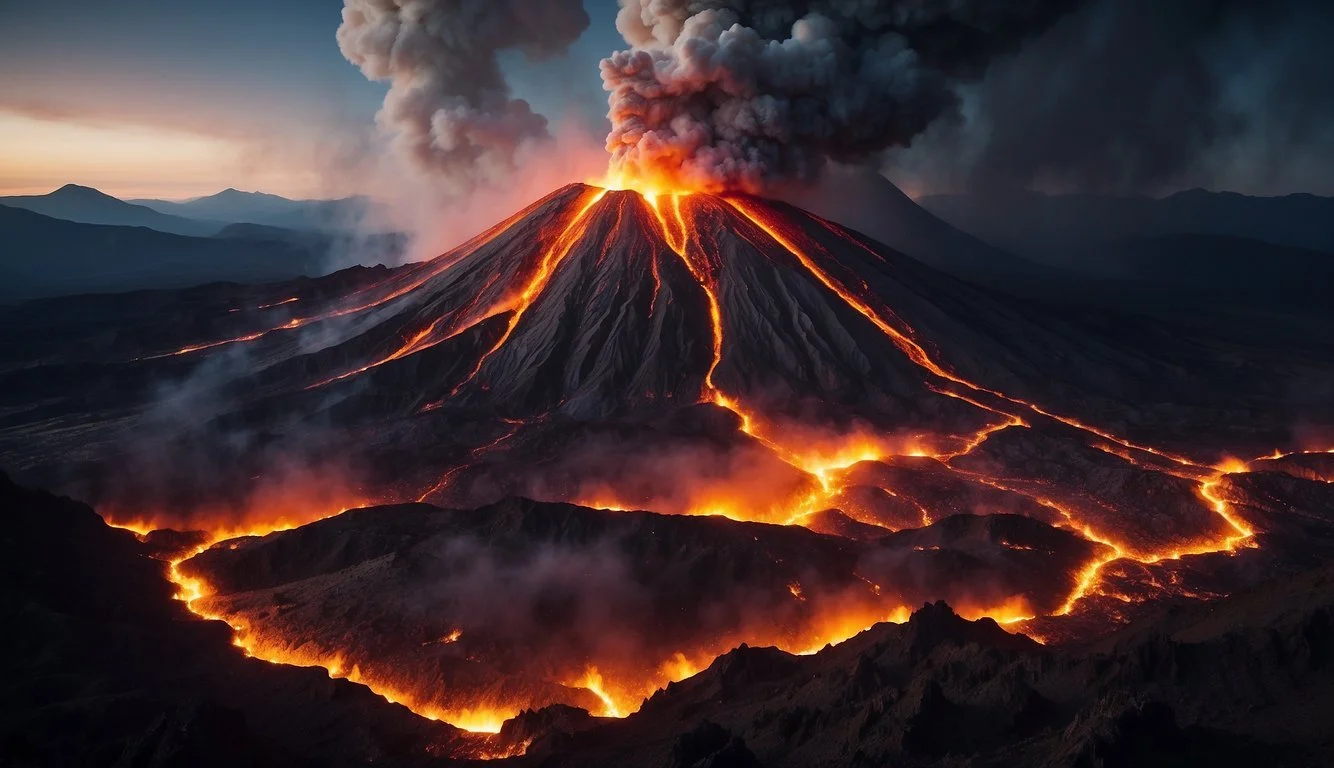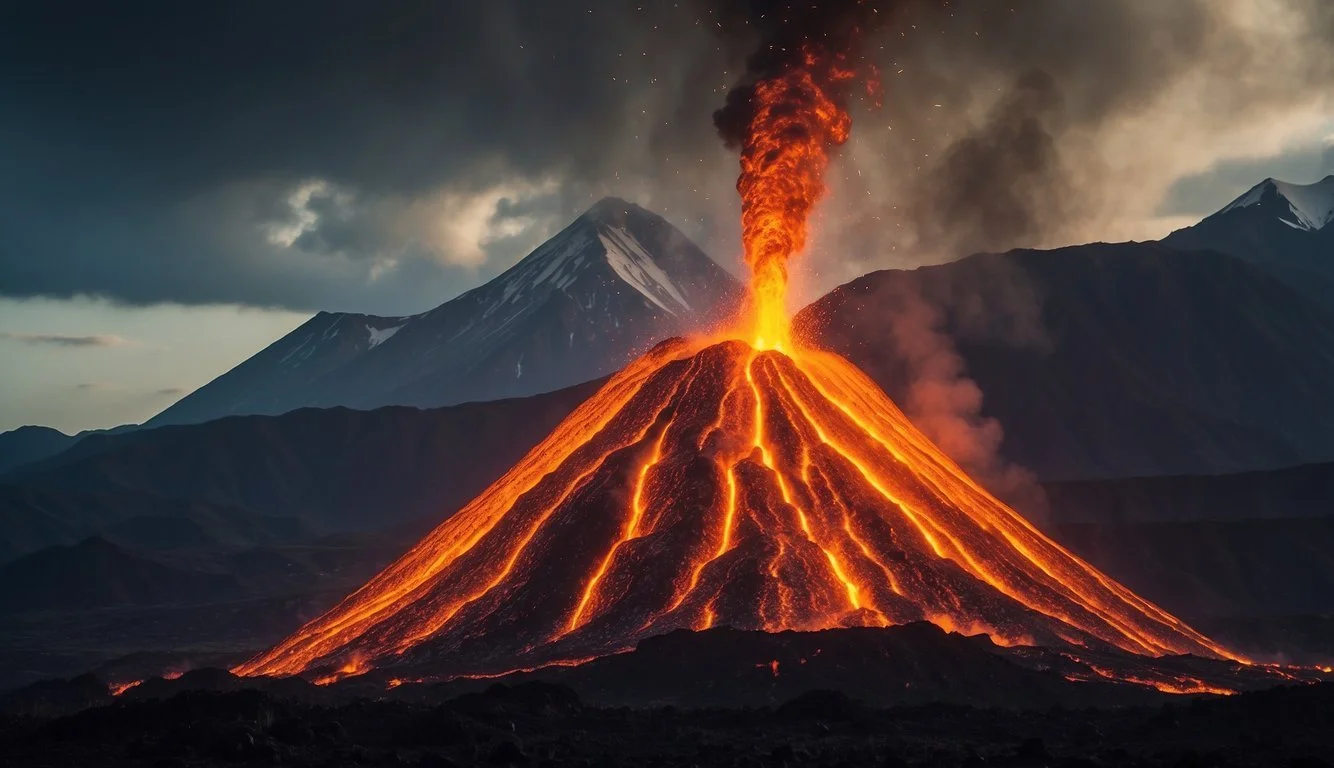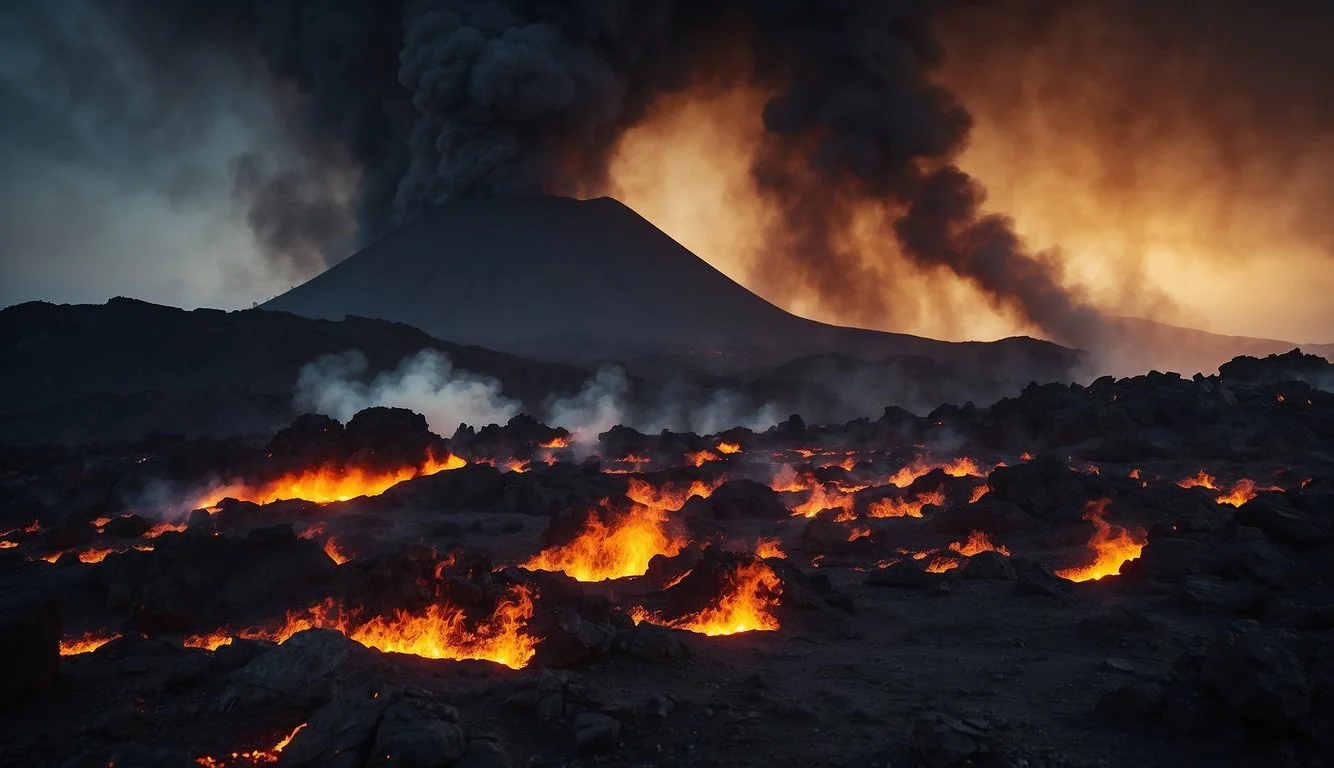Documentary Review: Into the Inferno (2016)
A Deep Dive into Volcanic Awe
Werner Herzog's "Into the Inferno" (2016) takes viewers to the very edge of active volcanoes around the globe, exploring not just their geological marvels but also their cultural and spiritual significance. This documentary is both visually breathtaking and intellectually stimulating, offering a deep dive into the awe-inspiring world of volcanic activity. Herzog, known for his inquisitive style, achieves a delicate balance between scientific inquiry and mythological exploration.
The film spans various sites, including the Vanatu Archipelago in the Galapagos, capturing both the raw power of nature and the timeless human fascination with these fiery giants. Herzog's collaboration with volcanologist Clive Oppenheimer adds an educational layer, making complex scientific concepts accessible to a broader audience. The blend of Herzog's storytelling and Oppenheimer's expertise results in a unique viewing experience that is as enlightening as it is captivating.
The remarkable footage, from helicopter shots over volcanic landscapes to close-ups of lava flows, ensures that the imagery remains etched in the viewer's mind. "Into the Inferno" is not just a documentary; it is an exploration into the profound and sometimes perilous relationship between humans and nature's most explosive phenomena.
Director's Profile: Werner Herzog
Werner Herzog is a German filmmaker born on September 5, 1942, in Munich. Renowned for his compelling documentaries and feature films, Herzog's work often explores extraordinary human experiences and natural wonders.
Herzog has directed over 60 films, encompassing both documentaries and narratives. His distinct style blends intense realism with a touch of the surreal, creating a unique cinematic experience.
Some of Herzog's notable works include:
Aguirre, the Wrath of God (1972)
Grizzly Man (2005)
Encounters at the End of the World (2007)
Awards and Recognition:
Silver Bear for Best Director at the Berlin International Film Festival (1968)
Best Documentary Award at the European Film Awards (2009)
Herzog's collaboration with volcanologist Clive Oppenheimer in "Into the Inferno" exemplifies his fascination with nature. They investigate active volcanoes and their cultural impact on nearby communities, showcasing Herzog’s ability to merge natural science with storytelling.
Herzog's influence extends beyond filmmaking. He has written books, directed operas, and founded the Rogue Film School, where he shares his unconventional filmmaking techniques.
Key Characteristics of Herzog’s Work:
Exploration of human extremities
Integration of natural elements
Use of non-professional actors
Herzog’s enduring impact on cinema is marked by his relentless pursuit of truth and beauty, pushing the boundaries of documentary filmmaking.
Synopsis of 'Into the Inferno'
Directed by Werner Herzog, "Into the Inferno" (2016) delves into the mesmerizing and deadly world of active volcanoes.
The documentary takes viewers on an incredible journey examining volcanoes in various locations, including the Vanuatu Archipelago and the Galapagos Islands.
Herzog teams up with volcanologist Clive Oppenheimer. Together, they explore the intersections between natural phenomena and human culture.
The film features breathtaking aerial shots. Melting lava, explosive eruptions, and the human settlements near these volatile mountains are showcased.
Herzog and Oppenheimer meet with locals and scientists. These interviews reveal diverse beliefs and stories tied to volcanic activity.
Key Locations Explored:
Ethiopia: Examining the Erta Ale volcano.
Iceland: Visiting the volcanic landscape and its influence on local culture.
Antarctica: Investigating the Mount Erebus volcano's unique properties.
North Korea: Assessing the political and cultural significance of Mount Paektu.
Notable Aspects:
High-quality cinematography and immersive visuals.
Insightful commentary by Werner Herzog.
Intriguing blend of science and anthropology.
Featured Interviews:
Clive Oppenheimer: Provides expert insights into volcanic behavior.
Local Inhabitants: Share their spiritual and practical relationships with volcanoes.
The documentary captures the raw power of nature while exploring its impact on human life and culture.
Historical Context and Background Information
Into the Inferno is a 2016 documentary directed by Werner Herzog, a renowned German filmmaker. The film explores the raw and compelling power of volcanoes, blending scientific insight with cultural reflection. Herzog's collaboration with volcanologist Clive Oppenheimer adds depth to the exploration of these natural phenomena.
The documentary spans multiple continents, featuring volcanoes from Ethiopia, Iceland, Indonesia, and beyond. Each location provides unique geological and cultural insights, showcasing not only the destructive forces of volcanoes but also their significance in human culture and history.
Volcanoes have been a subject of human fascination for centuries. Historically, they have inspired myths, influenced religions, and shaped civilizations. For indigenous communities, like those in the Vanuatu Archipelago, volcanoes are often revered and deeply integrated into their cultural identities.
Herzog's interest in combining natural wonder with human elements is evident throughout the documentary. Using archival footage, interviews, and breathtaking visuals, he delves into the ways in which volcanic eruptions have changed landscapes and human lives over millennia.
A pivotal aspect of the documentary is the intersection of science and humanities. By focusing on both the geological processes and the cultural narratives, Into the Inferno underscores the complexity and duality of volcanoes as both creators and destroyers. This approach provides a comprehensive view that appeals to viewers interested in both the physical sciences and human stories.
The historical context of Into the Inferno is enriched by Herzog's long-standing interest in nature and human resilience. Known for his contemplative style, Herzog presents volcanoes as more than just natural disasters, offering insight into their enduring influence on human life and myth.
Thematic Analysis
Werner Herzog's "Into the Inferno" dives into the mesmerizing allure of volcanic landscapes, examines the intimate connection between humanity and nature, and uncovers the cultural importance of volcanoes across various societies.
Exploration of Volcanic Landscapes
The documentary takes viewers on a visual journey across diverse volcanic terrains. From the Vanatu Archipelago to the farthest reaches of North Korea, the camera captures the raw, untamed beauty of these landscapes.
Each shot is meticulously crafted to highlight the unique geological formations, with lava flows resembling streams of glowing rivers and volcanic craters etched deep into the earth. The imagery serves not merely as a backdrop but as a focal point, allowing audiences to appreciate the sublime and sometimes terrifying beauty of the natural world.
Herzog’s cinematic prowess ensures that every location feels both isolated and connected to the larger narrative. The viewer experiences the varied textures and colors of volcanic ash, rock, and molten lava, all brought vividly to life through stunning cinematography.
Connection Between Humanity and Nature
"Into the Inferno" also investigates the deep-seated relationship between humans and these volatile natural wonders. Herzog and volcanologist Clive Oppenheimer explore not just the scientific aspects but also the emotional and spiritual connections people have with volcanoes.
Communities living near volcanoes often hold them in reverence, viewing them as living entities that must be respected and appeased. Through interviews and observations, the documentary reveals how these beliefs shape daily life, rituals, and even survival strategies.
The film suggests that volcanic eruptions, while destructive, also provide fertile soil and new land, symbolizing a complex bond between destruction and renewal. This duality underscores the intricate dance of dependency and fear that defines humanity's interaction with nature's most formidable forces.
Cultural Significance of Volcanoes
Volcanoes occupy a central place in the mythology and culture of many societies. "Into the Inferno" delves into how different cultures interpret and respond to these powerful natural phenomena.
In places like Indonesia and Ethiopia, volcanoes are not just geological features but pivotal to the spiritual and cultural fabric. Rituals, legends, and stories often personify volcanoes, attributing them with powers that go beyond their physical manifestations.
The film captures ceremonies, dances, and oral histories that highlight the reverence and fear these mountains of fire inspire. By documenting these practices, Herzog underscores the universal themes of respect and awe that volcanoes command across diverse cultures.
This exploration serves to illuminate the shared human experience of living in the shadow of such unpredictable and majestic natural features.
Cinematography and Visuals
The documentary "Into the Inferno" masterfully harnesses cinematography to evoke profound emotional responses from its audience. Viewers are left in awe by the visual spectacle of volcanic landscapes, captured with precision and artistry.
Camera Techniques
Werner Herzog employs a variety of innovative camera techniques throughout the film. The use of aerial shots provides sweeping views of vast volcanic terrains, enhancing the scale and majesty of the natural phenomena. Ground-level shots immerse viewers directly into the harsh environments, accentuating the power and danger of active volcanoes.
The documentary also incorporates close-up footage of molten lava, allowing audiences to witness the raw energy up close. Slow-motion sequences are used strategically, slowing down moments of volcanic eruptions to highlight their beauty and terror. This varied use of camera techniques not only keeps the visual experience dynamic but also deepens the impact of each scene.
Visual Style
Herzog's visual style in "Into the Inferno" is deliberate and evocative. The film uses a rich color palette dominated by reds, blacks, and grays, reflecting the fiery and ashen nature of volcanic activity. Contrasts between the bright, glowing lava and the dark, charred landscape are striking, creating powerful visual metaphors for destruction and creation.
The documentary often juxtaposes serene, untouched environments with scenes of violent volcanic eruptions. This contrast underscores the unpredictable and dual nature of volcanoes. The editing rhythm, punctuated by these juxtapositions, maintains a balance between tranquility and chaos. The film's visual style effectively captures the awe-inspiring and terrifying aspects of Earth's most volatile environments.
Music and Sound Design
The music and sound design in Into the Inferno play a crucial role in setting the film's intense atmosphere. The score often features haunting and ambient compositions that complement the awe-inspiring visuals of volcanic landscapes.
Composer: The film's score is created by a composer who specializes in documentary soundtracks. Their use of both orchestral and electronic elements helps to underscore the contrasting themes of natural beauty and lurking danger.
Ambient Sounds: The sound design incorporates a range of ambient noises, from the subtle rumbling of volcanoes to the distant calls of wildlife. These sounds ground the viewer in the environments being explored, enhancing the immersive experience.
Interview Accompaniments: During interviews, the background music is often minimal, allowing the voices of volcanologists and local inhabitants to take center stage. This approach ensures that the informative content remains the focus while still maintaining a cohesive auditory experience.
Contrasting Themes: The music varies between serene and ominous tones, reflecting the dual nature of volcanoes as both creators and destroyers. This duality is a recurring theme throughout Werner Herzog's work and adds a layer of depth to the documentary.
The careful balance of music and natural sounds serves to highlight the film's exploration of the powerful and unpredictable forces of nature. This meticulous sound design contributes significantly to the overall impact of Into the Inferno, making it a memorable and engaging experience for viewers.
Interviews and Narration
Into the Inferno stands out through its compelling interviews with volcanologists and local inhabitants, paired with Werner Herzog's distinctive narration style that adds depth and perspective to the documentary.
Notable Interviews
The film features Clive Oppenheimer, a volcanologist who provides expert insights into volcanic activity. His detailed explanations help viewers understand the science behind volcanoes and their impact on surrounding environments.
Additionally, interviews with local inhabitants from various volcanic regions highlight cultural perspectives and the personal significance of volcanoes in their lives. This dual focus on scientific and personal stories creates a rich, multifaceted narrative.
Herzog's Narration Style
Werner Herzog's narration is characterized by his distinctive voice and thoughtful delivery. He infuses the documentary with a sense of curiosity and philosophical reflection, prompting viewers to ponder broader existential questions.
Herzog's narration is not just informative but also emotive, often providing context that connects the volcanic phenomena to the human experience. His ability to weave historical and cultural references into the narrative enhances the film’s depth and engagement.
Critical Reception
"Into the Inferno" has been received positively by critics, who highlight Werner Herzog's compelling storytelling and the film's stunning visuals. The audience reception is similarly positive, with viewers appreciating the documentary's exploration of volcanic landscapes and their cultural significance.
Film Critic Reviews
Critics have praised "Into the Inferno" for its engaging narrative and breathtaking cinematography. Roger Ebert's review mentions the film's ability to captivate from the opening helicopter shots. On Rotten Tomatoes, the documentary holds a high approval rating of 92% based on 49 reviews, indicating widespread critical acclaim. Editions like Variety commend Herzog's ability to delve deep into the natural and human elements of volcanoes and the communities around them.
Audience Reception
Audience responses reflect admiration for Herzog's unique perspective on volcanic activity. Viewers are drawn to the way the film connects geological phenomena with cultural and spiritual elements. Many have noted the striking visuals and thought-provoking content. The documentary's success in merging scientific insights with profound human stories has resonated well, leading to an average rating of 7.5 on Rotten Tomatoes.
Comparative Analysis
Werner Herzog's Into the Inferno stands out for its exploration of volcanic activity and its cultural impacts. This section will examine similar documentaries and position this film within Herzog's notable body of work.
Similar Documentary Works
Several documentaries tackle themes similar to Into the Inferno, focusing on natural phenomena and their cultural implications. For example, Ron Fricke's Baraka (1992) and Samsara (2011) visually explore the relationship between humans and nature, though without Herzog’s narrative style. Encounters at the End of the World (2007), another work by Herzog, offers insight into the lives of people living in Antarctica, highlighting human perseverance in extreme environments. These films, while visually and thematically related, differ from Into the Inferno in that they focus less on the specific scientific and mythological aspects of volcanology. Key elements such as stunning cinematography and unique interviews are common, but Herzog's direct involvement and style impart a distinctive tone to the film.
Herzog's Filmography Context
Into the Inferno fits well within Werner Herzog's diverse filmography, exemplifying his interest in extreme natural phenomena and human responses to them. Previous works, such as Aguirre, the Wrath of God (1972) and Grizzly Man (2005), similarly capture the intersection of human ambition and nature’s overwhelming force. His collaboration with volcanologist Clive Oppenheimer follows this theme, providing scientific depth reminiscent of Cave of Forgotten Dreams (2010) where he teamed with experts to explore prehistoric art. Herzog’s trademark narration, rich visual storytelling, and philosophical musings are evident throughout, making Into the Inferno a true representation of his continuing exploration of man’s relationship with the untamed world.
Educational Value and Impact
"Into the Inferno" by Werner Herzog provides a comprehensive look into the world of volcanoes and their effects on human societies. Utilizing stunning visuals and expert commentary, the documentary offers viewers an in-depth view of volcanic activity and its geological, cultural, and historical significance.
The collaboration with volcanologist Clive Oppenheimer brings scientific rigor to the film. His interpretations help demystify the complex processes behind volcanic eruptions, making the subject accessible to a wider audience.
Interactive maps and high-definition imagery assist in illustrating key points. These elements help viewers grasp the scale and impact of volcanic phenomena in different regions, from the Galapagos to the Pacific Islands.
Historical Context: The film covers various cultures affected by volcanoes, using examples from history. This approach helps audiences understand how volcanic events have shaped human civilizations.
Herzog's nuanced style engages audiences on both intellectual and emotional levels. The documentary goes beyond scientific explanations, exploring the myths, rituals, and beliefs surrounding volcanoes, adding a rich cultural layer to the educational content.
Simplicity and Depth: The documentary strikes a balance between complexity and simplicity. It tackles sophisticated topics without overwhelming the audience, making it suitable for both students and general viewers.
Teacher and student resources, such as discussion guides and study materials, can enhance the educational value of "Into the Inferno." These additions make it a useful tool for classroom learning and independent study.
"Into the Inferno" serves as both an educational resource and a compelling narrative, bridging the gap between science and storytelling. The documentary stands out for its ability to teach and inspire curiosity about the natural world.
Distribution and Accessibility
Into the Inferno (2016), directed by Werner Herzog, is accessible through several major streaming platforms. It initially premiered on Netflix, making it readily available to a wide audience globally. This partnership allowed many viewers to experience the documentary from the comfort of their homes.
The film has also been included in various digital libraries, enhancing its reach. It can be found on Amazon Prime Video, Google Play Movies, and Apple iTunes. Many of these platforms offer purchase or rental options, ensuring flexible viewing choices.
For traditionalists who prefer physical media, Into the Inferno is available on DVD and Blu-ray. These formats can be purchased from major retailers like Amazon and Barnes & Noble. These options cater to those who value a tangible collection of their favorite documentaries.
Additionally, public libraries in various cities provide copies of the film, expanding access to those who might not subscribe to streaming services. This ensures that a broader audience can appreciate Herzog's exploration of volcanos and cultural perspectives.
In terms of language accessibility, the documentary includes subtitles in multiple languages, enhancing inclusivity for non-English speakers. This feature ensures that viewers across different linguistic backgrounds can engage with the film.
In summary, whether through streaming services, physical media, or public libraries, Into the Inferno is widely accessible to audiences around the world. Its varied distribution channels demonstrate a commitment to reaching as many viewers as possible.




